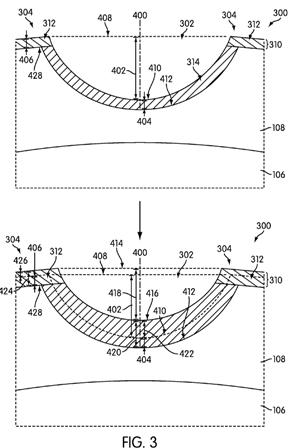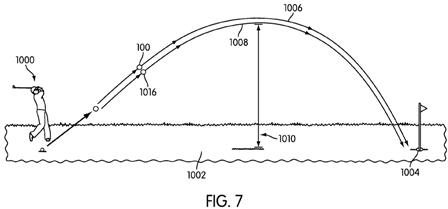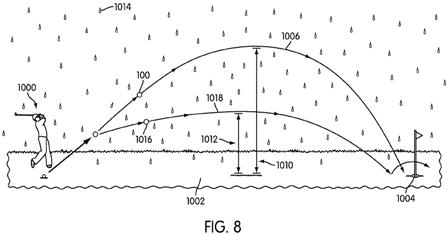Genius, Genius but Impossible to Pull Off, or Just Plain Wacky?
Today a Nike Golf patent application published that seems like such a good idea, albeit one that sounds much easier to say than actually do, that I am left wondering whether it has previously been done. You may recall a prior post regarding a Nike application directed to a golf club having hydrophobic and hydrophilic portions; well this week they have taken the hydrophilic concept to golf balls in US Pub. No. This disclosure provides a golf ball having a coating layer made from a hydrophilic water-swellable material. The hydrophilic water-swellable material undergoes a physical change from a dry state to a wet state upon exposure to water. The wet state may be associated with shallower dimple depths, and the coating layer being softer, than the dry state. The use of such a coating layer may allow the golf ball to compensate for the negative effects of wet weather conditions. Also provided is a method of manufacturing a golf ball.
That’s right, get the ball wet and the dimples become shallower and the ball becomes softer!

The application goes on to explain:
[0001] The present disclosure relates generally to the field of golf balls. Specifically, the present disclosure relates to a golf ball having a coating layer that is hydrophilic in such a manner as to cause the coating layer to swell.
.
.
.
[0005] Dimple depth, in particular, can significantly affect the aerodynamics of the golf ball’s flight. As is generally known, shallower dimples tends to result in the golf ball rising higher during flight. Conversely, the deeper the golf ball dimples, the lower the golf ball’s flight. It is believed that these tendencies are caused by decreased lift due to greater turbulence of the air inside deeper dimples, although many different aerodynamic phenomenon likely come into play.[0006] Similarly, the hardness of the golf ball’s outer layer(s) can also significantly affect a golf ball’s play characteristics. Generally, a golf ball with a harder cover layer will achieve reduced spin, but will achieve greater distances. A golf ball with a harder cover layer will therefore be better for drives, but more difficult to control on shorter shots. On the other hand, a golf ball with a softer cover will generally experience more spin and therefore be easier to control and stop on the green, but will lack distance off the tee.
[0007] Consequently, a golfer may desire to use a golf ball having different dimple depths or different cover layer hardness, depending on a variety of factors. For example, weather conditions or the golfer’s athletic abilities may affect whether shallow dimples or deeper dimples, or a harder cover layer or a softer cover layer, will better achieve the desired play characteristics.[0008] In particular, wet play conditions due to rainy weather can significantly affect a golf ball’s play characteristics. During wet weather, the presence of water on the surface of the golf ball decreases friction between the golf club face and the golf ball. This decreased friction causes the golf ball to experience a lower trajectory flight path, and also decreases spin on the ball. This decreased spin reduces the amount of control the golfer has over the golf ball’s flight path and landing conditions. Wet weather conditions therefore present specific challenges to achieving optimal golf ball play characteristics.
.
.
.
[0031] Dimple 102 has a first dimple depth 202 in the top portion of FIG. 2. The top portion of FIG. 2 will generally be referred to as “the dry state” to denote the state of ball 100 before exposure to moisture levels sufficient to trigger absorption by ball 100. First dimple depth 202 is defined as the distance between first dimple bottom surface 210 and line 208. First dimple depth 202 as shown is measured at the center 200 of the dimple. However, the phrase “dimple depth” as used in the present disclosure need not necessary be measured at center 200 of dimple 102, but may generally be understood as the distance between the top 208 of dimple 102 and the bottom surface 210 of dimple 102 at any particular point, or (for example) as an average of this distance across dimple 102.[0032] As shown in the lower portion of FIG. 2, coating layer 110 is configured to be capable of undergoing a physical change. The bottom portion of FIG. 2 will generally be referred to as “the wet state” to denote the state of ball 100 after exposure to moisture for a sufficient length of time so as to allow coating layer to absorb moisture. In the embodiment shown, the physical change is an expansion, such that coating layer 110 expands as it changes from the dry state to the wet state. The expansion causes the shape of the coating layer to change in various ways. For example, land portions 112 of the coating layer 110 expand from dry state thickness 206 to wet state thickness 224, the difference between these thicknesses being distance 226. Land portions 112 of coating layer 110 therefore have a wet state topmost surface 214. Furthermore, dimple portion 114 of coating layer 110 expands from dry state thickness 204 to wet state thickness 220, the difference between these thicknesses being distance 222. Dimple portion 114 of coating layer 110 therefore has a new wet state surface 216.
[0033] In the particular embodiment shown, the land portions 112 and the dimple portion 114 of coating layer 110 have the same linear swelling ratio. The linear swelling ratio, also referred to in the art as the linear swelling rate, is the ratio of the change in thickness to the original thickness, namely the ratio of distance 226 to distance 206, and the ratio of distance 222 to distance 204. In other embodiments, discussed below, the linear swelling ratios of the land portions and the dimple portion may be different.
[0034] More specifically, in particular embodiments, the expansion that occurs when the golf ball transitions from the dry state to the wet state may cause the dimple depth to change. In other words, the dry state may be associated with first dimple depth 202 while the wet state may be associated with a second dimple depth 218. Second dimple depth 218 is measured between wet state topmost land surface and wet state dimple bottom surface 216. Generally, second dimple depth 218 may be any dimple depth that is different from first dimple depth 202. However, in the particular embodiment shown, second dimple depth 218 is less than first dimple depth 202. In certain embodiments, second dimple depth 218 may be less than first dimple de
pth 202 by a specific percentage. For example, second dimple depth 218 may be 75% or less than dimple depth 202, or second dimple depth 218 may be 50% or less than first dimple depth 202, or second dimple depth 218 may be 33% or less than first dimple depth 202.[0035] In the particular embodiment shown in FIG. 2, the change in dimple depth between the dry state and the wet state is caused by the difference in thickness of the land area portions 112 and the dimple portion 114 of the coating layer 110, even though the linear expansion ratio is the same in these two areas. In other words, the greater thickness 204 of the dimple portion 114 of coating layer 110 as compared to thickness 206 in the land portions 112 causes the distance 222 swelled in the dimple to be larger than the distance 226 swelled on the land.
[0036] With reference back to FIG. 1, the changes in dimple 102 shown in FIG. 2 may occur with respect to one or more of the plurality of dimples across the entirety of golf ball 100. In certain embodiments, fewer than all of the plurality of dimples may be configured to undergo a physical change from a dry state to a wet state. For example, a certain subset of the plurality of dimples arranged in a desired pattern may be configured to so change. Such a pattern may be, for example, spherically symmetric or non-spherically symmetric. Certain symmetric patterns of the dimples configured to change may meet United States Golf Association (U.S.G.A.) standards for regulation play golf balls. Specifically, a golf ball may include a pattern of dimples configured to change, such that the pattern of changeable dimples causes the golf ball to meet U.S.G.A. rules Section 7.3 standards for symmetry.
[0037] In other embodiments, as shown in FIG. 1, all of the plurality of dimples 102 may be configured to undergo a physical change from a dry state to a wet state. In other words, all of the dimples 102 on golf ball 100 may have the same first dimple depth 202 prior to any change in coating layer 110. Consequently, after a change in coating layer 110, all of the dimples 102 may have the same second dimple depth 218. The change in the dimples therefore may take place uniformly across all of the plurality of dimples.
[0038] In addition to the changes discussed above, coating layer 110 may undergo other physical changes when transitioning from the dry state to the wet state. For example, coating layer 110 may change hardness. The dry state may be associated with coating layer 110 having a first hardness, while the wet state may be associated with coating layer 110 having a second hardness. The first hardness and the second hardness may generally be of any hardness value commonly associated with golf ball outer layers, for example about 40 to about 80 on the Shore D scale. The first hardness and the second hardness may be different hardness values. In particular embodiments, the second hardness is softer (i.e. less hard) then the first hardness. In some embodiments, the second hardness is at least five units on the Shore D scale softer than the first hardness. In other embodiments, the second hardness is at least 10 units on the Shore D scale softer than the first hardness.
[0039] Coating layer 110 may be comprised of a hydrophilic water-swellable material. A hydrophilic water-swellable material may be any material that includes polar charges on the molecules therein capable of forming hydrogen bonds with water, and absorbs water so as to physically change dimension by swelling. The hydrophilic water-swellable material undergoes a physical change from the dry state to the wet state upon exposure to water. The nature of the hydrophilic water-swellable material is discussed in further detail below.[0040] FIG. 3 shows a second embodiment of a golf ball 300 in accordance with the present disclosure. Golf ball 300 includes a coating layer 310 overlapping at least a dimple 302 portion of cover layer 108, and overlapping at least one land area 304 portion of cover layer 108. In this embodiment, land portion 312 of coating layer 310 comprises a first hydrophilic water-swellable material, and dimple portion 314 of coating layer 310 comprises a second hydrophilic water-swellable material. As shown in the top portion of FIG. 3, the thickness of coating layer 310 is constant throughout the dimple portion 314 and land portion 312 when in the dry state. Namely, thickness 404 (as measured between top surface 412 of cover layer 108 in dimple 302 and dry state dimple bottom surface 410) is the same as thickness 406 (as measured between top surface 428 of cover layer 108 in land area 304 and line 408). This contrasts with the embodiment of FIG. 2 wherein these portions have different thicknesses in the dry state (as well as in the wet state), as discussed above.
[0041] The embodiment of FIG. 3 allows for the use of two different materials having different linear swelling ratios. Namely, first hydrophilic water-swellable material 312 has a first linear swelling ratio, and second hydrophilic water-swellable material 314 has a second linear swelling ratio that is different from the first linear swelling ratio. In particular embodiments, the second linear swelling ratio is greater than the first linear swelling ratio.
[0042] Accordingly, when golf ball 300 transitions to the wet state, dimple portion 314 of coating layer 310 may swell a larger distance than land portions 312 swell. Specifically, dimple portion 314 swells from thickness 404 in the dry state to thickness 420 in the wet state. The difference between thickness 404 and thickness 420 is distance 422, as shown. On the other hand, land portions 312 swell from thickness 406 in the dry state to thickness 424 in the wet state. The difference between thickness 406 and thickness 424 is distance 426. In the particular embodiment shown, distance 422 may be larger than distance 426. The linear swelling ratio of dimple portion 314 is thus the ratio of distance 422 to distance 404, which is much larger than the linear swelling ratio of land portion 312 as defined by the ratio of distance 426 to distance 406. Therefore, dimple 302 has a first dimple depth 402 (as measured between dry state dimple bottom surface 410 and line 408 at dimple center 400) when in the dry state, and a second dimple depth 418 (as measured between wet state dimple bottom surface 416 and line 414, at center of dimple 400) when in the wet state. In the embodiment shown, second dimple depth 418 may be less than first dimple depth 402.
.
.
.[0062] FIG. 7 and FIG. 8 show how golf balls in accordance with the present disclosure may be used to compensate for wet weather conditions. Although not wishing to be bound by any particular usage or effect, the change in dimple depth and hardness from the dry state to the wet state may generally allow golf ball 100 to compensate for the effects of wet weather conditions that would otherwise disadvantage conventional golf balls. Specifically, during wet weather, water on a conventional golf ball may decrease the amount of friction between a golf club face and the golf ball during a shot, cause a golf ball to experience a lower trajectory flight path and reduced spin.
[0063] FIG. 7 shows a golfer 1000 golfing in fair (i.e., normal,
or non-wet) weather conditions. Under these conditions, golf ball 100 is in the dry state, as shown in FIG. 1. Specifically, golf ball 100 has a first dimple depth and coating layer 110 has a first hardness value. Golf ball 100 follows flight path 1006 toward the tee 1004, achieving a maximum vertical distance of 1010. For comparison, conventional golf ball 1016 is shown following a substantially similar flight path 1008. Conventional golf ball 1016 has the same general aerodynamic properties, such as dimple depth and cover layer hardness, as golf ball 100 in the dry state.[0064] FIG. 8 shows golfer 1000 golfing in wet-weather conditions. Specifically, rain 1014 wets golf ball 100 and golf ball 1016, as well as the green 1002. As a result of being exposed to water in the form of rain 1014, golf ball 100 undergoes a physical change from the dry state to the wet state (as shown in FIG. 1). The wet state of golf ball 100 has a second dimple depth that may be smaller than the first dimple depth, and has a second hardness that may be softer than the first hardness. As a result of the wet weather conditions, conventional golf ball 1016 experiences reduced friction between its cover layer and the golf club face during the shot. Therefore, conventional golf ball 1016 first experiences a flight path trajectory 1018 having a lower maximum height 1012. Conventional golf ball 1016 also experiences reduced spin, resulting in poor control of the shot upon landing.
[0065] In contrast, golf ball 100 in the wet state compensates for the reduced friction by having a reduced dimple depth and a softer outermost layer. The reduced dimple depth causes golf ball 100 to experience a flight path 1006 that is otherwise higher than the reduced friction would otherwise cause it to have. Furthermore, the softer outermost layer causes golf ball 100 to experience more spin than the reduced friction would otherwise cause, resulting in golf ball 100 having better control upon landing. Accordingly, the present disclosure provides golf balls which may be used equally well in both fair weather conditions and wet weather conditions.
OK, so here are my great ideas…(drum roll please)… apply the same principle to the sole of shoes so that the traction capability increases during wet weather, or how about a golf grip with projections that expand a bit when wet to increase the wet weather playability. Just send me a check for $1 million and you can launch either of the products.
David Dawsey – Keeping an Eye on Golf Ball Inventions
PS – click HERE to read about a spin indicating golf ball that changes colors


